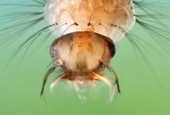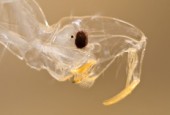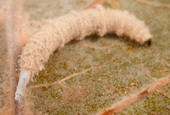True flies, Midges, Mosquitoes (order Diptera)
Contained families:
Culicidae (Mosquitoes)
Simuliidae (Black flies)
Chaoboridae (Phantom midges)
Chironomidae (Non-biting midges)
Ceratopogonidae (Biting midges)
Tipulidae (Crane flies)
Tabanidae (Horse flies)
Syrphidae (Hover flies)
Ptychopteridae (Phantom crane flies)
![]()
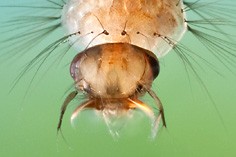
Mosquitoes
(order Diptera, family Culicidae)
Feeding:
Collectors/gatherers/filterers – most larvae have fan-like mouth brushes to collect organic matter from the water.
Habitat:
Mosquito larvae occur in almost any type of still water habitat.
Movement:
Both larvae and pupae swim by flexing their bodies.
Size:
Mature larvae reach sizes around 12 mm.
Life cycle:
Mosquitoes undergo complete metamorphosis. Their life cycle includes four stages – egg, larva, pupa and adult. Most species require just a few weeks to an adult capable of reproduction. Consequently, mosquitoes can produce many generations per year (especially in tropical regions).
Introduction:
Larvae of mosquitoes can be found in large variety of still waters. The most abundant they are in small ponds, swamps, puddles and backwaters of rivers and streams. Suitable habitats are unintentionally created even by humans. Discarded tires, old containers, vessels and other waste, where the water can seep into, may provide temporary habitats for the larval development.
Larvae have an elongated and soft body. Well developed, rounded head is sclerotized and distinctly separated from the thorax. Thorax is large and thicker than the rest of the body. A pair of fan-like mouth brushes is used for feeding. Larvae often position themselves head down from the surface and filter algae and organic particles dispersed in the water.
Although larvae often possess breathing siphon, they get dissolved oxygen from the water through their soft skin as well. Some larvae have developed gills, in order to increase the body surface and overall breathing efficiency.
Larvae do not construct cocoons and grow until they are able to transform into pupae. Viewed from the side, mosquito pupae are comma-shaped, with head and thorax fused together (cephalothorax). Pupae can swim actively by flexing their abdomen, which is in idle state curved around. Pupae have a pair of short, conical structures called horns or trumpets. These extensions enable the pupae to breathe atmospheric oxygen.
Whereas the larvae feed constantly, pupae do not feed and spend most of their time hanging from the surface. When emerging, the skin on the thorax splits and the adult mosquito climbs out.
Mosquitoes have modified mouthparts to suck the fluids, but only female mosquitoes need blood of vertebrates for egg development. In some regions, this nuisance causes devastating effects on tourism, livestock or wildlife. And the most important, some are capable of transmitting serious diseases to humans.
Mosquitoes (Culex sp.):
Mosquitoes (Anopheles sp.):
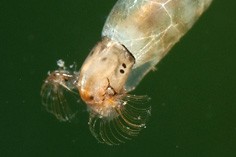 Black flies
Black flies
(order Diptera, family Simuliidae)
Feeding:
Collectors/filterers using their fan-like mouth brushes to collect algae, detritus and organic debris drifting in stream.
Habitat:
Black fly larvae inhabit wide range of flowing waters.
Movement:
Clingers moving slowly by alternately holding the substrate with proleg and suction disc. However, larvae do not change their position often.
Size:
Mature larvae reach sizes up to 15 mm.
Life cycle:
Black flies undergo complete metamorphosis. Their life cycle includes four stages – egg, larva, pupa and adult. If conditions permit, black flies produce several generations per year.
Introduction:
There is an accepted custom for writing the common names for insects, which have “fly” included. If the name is for a group of insects other than Diptera, the name is written as one word (e.g. dragonfly, mayfly, stonefly). If the insects belong to the order Diptera and the “fly” is included, the names are written as two words (e.g. black fly, crane fly, horse fly).
Black fly larvae occur in variety of flowing waters from large rivers of moderate current, to the fastest sections of mountain streams. They usually live in dense colonies, although some seem to be territorial and keep others at the distance of the body length.
Head bears two pairs of eye spots, short antennae and two fan-like brushes projecting from each side of the mouth. Rear third of the soft body is swollen and pear-shaped. Abdomen terminates in an attachment disc, which is circled by many small hooks. These hooks are used to anchor the larvae to stones, plants or any other solid surface.
Larvae first make a patch of silk, secreted from the salivary glands on the mouth, then cling on it and firmly adhere with their suction discs. They seek places where the speed of the current is optimal for filtering food and bringing sufficient quantity of oxygenated water. Larvae have closed breathing system and breathe through the entire skin surface.
Larvae mostly stand in one place, bent by the current and filtering the water. When disturbed or swept away, larvae immediately let out silken thread, attach it to the substrate and go downstream with the current. This dragline enables the larvae to return to their original position.
As like in mosquitoes, only females require blood of vertebrates for egg development. Presence of black flies may practically eliminate tourism in some regions. They pose a threat in tropics, because of transmitting serious diseases to humans.
Black flies (Simuliidae):
 Phantom midges
Phantom midges
(order Diptera, family Chaoboridae)
Feeding:
Predaceous larvae have modified antennae for grasping a small prey.
Habitat:
Chaoborid larvae occur in variety of still water habitats.
Movement:
Both larvae and pupae swim by flexing their bodies.
Size:
Mature larvae reach sizes around 15 mm.
Life cycle:
Phantom midges undergo complete metamorphosis. Their life cycle includes four stages – egg, larva, pupa and adult. If conditions permit, phantom midges produce several generations per year.
Introduction:
Chaoborid larvae inhabit still waters of ponds, marshes and lakes. Some species can be found even in high depths.
Phantom midge larvae have an elongated, soft body with swollen thoracic segments. The head is sclerotized and bent down on the obvious neck.
Modified antennae, equipped with long movable bristles, are used to grab a prey and bring it to chewing mouthparts. Predaceous larvae feed mostly on zooplankton, but will try to catch any other small animal within their reach. Population of mosquitoes may be effectively reduced, when phantom midges occur in large numbers.
The common name phantom midges comes from transparent bodies and stealthy movements of the larvae. Chaoborids perform vertical migration in the water column as they follow the behavior of zooplankton (up during the night and down by day).
Only the eyes and two pairs of air sacs, located inside the thorax and by the end of the abdomen, are clearly visible in the water. Air sacs allow the larvae to maintain in horizontal position and regulate their buoyancy. The last abdominal segment is equipped with a fan of bristles for swimming.
Larvae breathe through the entire skin surface, but air sacs provide additional air supply, which enable them to stay in deep water with low level of dissolved oxygen. As like in mosquitoes, larvae do not construct cocoons and grow until they are able to transform into pupae.
Pupae can swim by wiggling their bodies, but do not feed. Pupae have a pair of air-filled horns holding them in vertical position. When emerging, the skin on the thorax splits and the adult midge climbs out. Adults are short-lived and do not feed on blood.
Phantom midges (Chaoboridae)
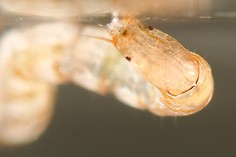 Non-biting midges
Non-biting midges
(order Diptera, family Chironomidae)
Feeding:
Collectors/gatherers/filterers/predators – most larvae feed on detritus, although some species consume other small invertebrates as well.
Habitat:
Non-biting midge larvae can be found in any type of freshwater habitat from temporary puddles or seeps, to the bottoms of deep lakes and rivers.
Movement:
Burrowers/clingers/swimmers – larvae mostly occur in soft sediments or tangles of vegetation. If needed, larvae can swim by wiggling their body.
Size:
Mature larvae of some species reach sizes up to 30 mm.
Life cycle:
Non-biting midges undergo complete metamorphosis. Their life cycle includes four stages – egg, larva, pupa and adult. If conditions permit, chironomids produce several generations per year.
Introduction:
Diptera (true flies) is a large and diverse order of insects, in terms of number is second only to beetles (Coleoptera). Like in other large orders, most species are terrestrial. However, among aquatic members, Diptera is the most diverse of all insect orders. Consequently form an extremely important part in aquatic and related food webs.
Midge larvae are found in almost any aquatic habitat, either swimming in the open water, clinging on the submerged objects, or burrowing in sediments at the bottom.
Chironomid larvae significantly resemble worms, but their rounded head is sclerotized and distinctly separated from the thorax. The head is usually darker than the rest of elongated and soft body. Most larvae have two pairs of prolegs. One pair is located on the firs thoracic segment and the second on the last abdominal segment. Prolegs are equipped with small hooks, which help the larvae in movement and to hold on the substrate.
Non-biting midge larvae get dissolved oxygen from the water through their soft skin. Body often terminates in tufts of gills to increase the body surface and overall breathing efficiency.
Blood worm is the common mane of red coloured larvae. The red coloration is caused by the presence of invertebrate form of hemoglobin. This adaptation is unique among the insects and allows the larvae to store molecules of oxygen within their bodies. Thus the larvae can survive in habitats with extremely low levels of dissolved oxygen.
Most species build tubes or fragile tunnels of sediments and their own silk secreted from the salivary glands and pupate within their retreats. Others have swimming pupae as like in mosquitoes.
Short-lived adults do not bite animals, let alone humans. They may be observed in large swarms, where looking for mates.
Non-biting midges (Chironomidae):
 Biting midges
Biting midges
(order Diptera, family Ceratopogonidae)
Biting midges (Ceratopogonidae):
 Crane flies
Crane flies
(order Diptera, family Tipulidae)
Crane flies (Tipulidae):
Horse flies
(order Diptera, family Tabanidae)
Horse flies (Tabanidae):
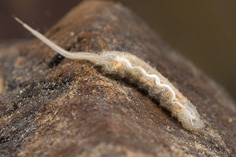 Hover flies
Hover flies
(order Diptera, family Syrphidae)
Hover flies (Syrphidae):
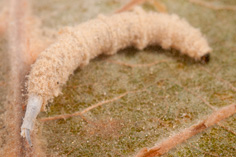 Phantom crane flies
Phantom crane flies
(order Diptera, family Ptychopteridae)
Phantom crane flies (Ptychopteridae):

